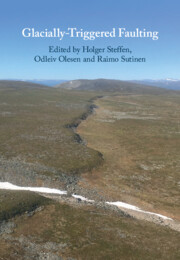Book contents
- Glacially-Triggered Faulting
- Glacially-Triggered Faulting
- Copyright page
- Contents
- Figures
- Tables
- Contributors
- Preface
- Part I Introduction
- Part II Methods and Techniques for Fault Identification and Dating
- Part III Glacially Triggered Faulting in the Fennoscandian Shield
- Part IV Glacially Triggered Faulting at the Edge and in the Periphery of the Fennoscandian Shield
- 15 Lateglacial and Postglacial Faulting in Denmark
- 16 Glacially Induced Faults in Germany
- 17 Glacially Induced Faulting in Poland
- 18 Soft-Sediment Deformation Structures in the Eastern Baltic Region
- Part V Glacially Triggered Faulting Outside Europe
- Part VI Modelling of Glacially Induced Faults and Stress
- Part VII Outlook
- Index
- References
16 - Glacially Induced Faults in Germany
from Part IV - Glacially Triggered Faulting at the Edge and in the Periphery of the Fennoscandian Shield
Published online by Cambridge University Press: 02 December 2021
- Glacially-Triggered Faulting
- Glacially-Triggered Faulting
- Copyright page
- Contents
- Figures
- Tables
- Contributors
- Preface
- Part I Introduction
- Part II Methods and Techniques for Fault Identification and Dating
- Part III Glacially Triggered Faulting in the Fennoscandian Shield
- Part IV Glacially Triggered Faulting at the Edge and in the Periphery of the Fennoscandian Shield
- 15 Lateglacial and Postglacial Faulting in Denmark
- 16 Glacially Induced Faults in Germany
- 17 Glacially Induced Faulting in Poland
- 18 Soft-Sediment Deformation Structures in the Eastern Baltic Region
- Part V Glacially Triggered Faulting Outside Europe
- Part VI Modelling of Glacially Induced Faults and Stress
- Part VII Outlook
- Index
- References
Summary
Recent studies have shown that the low seismicity of northern Germany is characterized by fault activity caused by the decay of the Late Pleistocene (Weichselian) ice sheet. Several faults and fault systems show evidence of neotectonic activity, all of which are oriented parallel to the margin of the Pleistocene ice sheets. The timing of fault movements implies that the seismicity in northern Germany is likely induced by varying lithospheric stress conditions related to glacial isostatic adjustment, and the faults thus can be classified as glacially induced faults. For the Osning, Harz Boundary and Schaabe faults, this is supported by numerical simulation of glacial isostatic adjustment-related stress field changes. Glacial isostatic adjustment is also a likely driver for the historical and parts of the recent fault activity. Glacial isostatic adjustment is also described for the Alps, but it is difficult to clearly distinguish between reactivation of faults in the foreland of the Alps due to the Alpine collision and glacial isostatic adjustment.
Keywords
- Type
- Chapter
- Information
- Glacially-Triggered Faulting , pp. 283 - 303Publisher: Cambridge University PressPrint publication year: 2021
References
- 4
- Cited by

